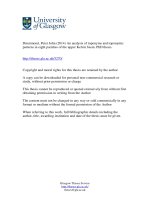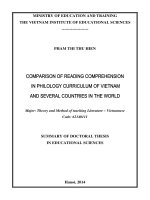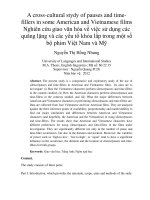LIST OF FISHES AND REPTILES SOMALI-LAND IN 1896, MEEK 1897k
Bạn đang xem bản rút gọn của tài liệu. Xem và tải ngay bản đầy đủ của tài liệu tại đây (1.62 MB, 26 trang )
FIELD COLUMBIAN MUSEUM
PUBLICATION
22.
VOL.
ZOOLOGICAL SERIES.
LIST
I,
No.
8.
OF FISHES AND REPTILES
OBTAINED BY
FIELD COLUMBIAN
MUSEUM EAST AFRICAN
EXPEDITION
TO
SOMALI -LAND
IN
1896.
BY
S.
E.
MEEK,
ASSISTANT CURATOR OF DEPARTMENT.
D. G. ELLIOT, F. R.
S. E.,
CURATOR OF DEPARTMENT.
CHICAGO, U. S.
November,
A
1897.
The
collection of fishes brought back by the Field
Museum
East
African Expedition were, with one exception, taken in the waters of
The exception
the Gulf of Aden, near the town of Aden.
species Pterois
coast.
The
ellioti,
which was obtained
at
lack of time alone prevented us from
larger collection, as
we only remained
a
is
the
new
Berbera, on the African
week
in
making
Aden,
a
for fish
much
were
The reptiles
very plentiful and specimens were easily obtained.
were procured at various places as we journeyed through the land.
Lizards were very plentiful wherever we went, especially the small
species, but snakes were only occasionally seen.
Perhaps, as we did
not hunt for them,
may account for their apparent rarity. Many are
I
and
was
poisonous,
surprised to find a green tree snake, nine feet
long, that was killed by Mr. Dodson near our camp at Bohobgashan,
was furnished with long fangs and was evidently
tomer.
The
back with
shot injured the skin so
much
that
it
a
dangerous cuswas not brought
D. G. E.
us.
163
PISCES.
SERRANID^E.
Epinephelus tauvina
Five specimens.
No.
(Forskal).
1
FIELD COLUMBIAN MUSEUM
66
ZOOLOGY, VOL.
i.
Pristopoma punctulatum Ruppel.
Two
specimens.
Pectoral fin slender,
its tip reaching anal fin.
The deepest
portion of the body is at the origin of the first three dorsal spines.
Profile from the first dorsal spine to the tip of the snout nearly
straight.
Longitudinal narrow stripes on the sides of the body.
Pristopoma argenteum
(Forskal).
One specimen.
Pristopoma maculatum
Six specimens.
No.
(Bloch).
EAST AFRICAN COLLECTION FISHES
Nov. 1897.
MEEK.
167
Diagramma gaterina (Forskal).
Two specimens.
Those on
Black spots on the sides about as large as pupil.
upper and posterior part of the body are largest.
Profile strongly decurved.
Mesoprion fulviflamma
(Forskal).
Twelve specimens.
Therapon jaruba
(Forskal).
Five specimens.
Genyorge bengalensis
(Bloch).
Three specimens.
According to Dr. Day, this species is very variable. It is
likely that more than one species is included in Dr. Day's description.
The specimens
before
me
are very slender, depth
2^
in the
length.
Genyorge gibba
Two
(Forskal).
specimens.
The
profile in the larger specimen, 15 inches in length, is conin
the smaller specimen, 7 inches, convex.
cave,
Genyorge rivulata (Cuv. and
One specimen.
Length,
io^4
inches;
Val.).
head,
2^;
depth,
2^/3;
D., x-i^; A.,
iii-n; scales, 56; eye, \y^\ snout, 2^i; maxillary, 2^.
Color dark.
Scales on lower sides of the body with
white
edges.
A white spot on side above the lateral line and near the extremity of the pectoral.
Lethrinus harak (Forskal).
Two
specimens.
Black blotch on the side about twice as long as deep;
equals the diameter of the eye.
its
depth
FIELD COLUMBIAN MUSEUM
i68
Lethrinus nebulosus (Forskal).
Thirteen specimens.
o.
ZOOLOGY, VOL.
i.
LIBRARY
OF THE
of ILLINOIS.
UNIVERSITY
FIELD COLUMBIAN MUSEUM.
PTEROIS ELLIOTI.
ZOOLOGY,
(TWICE NATURAL
SIZE.)
PL. XL.
EAST AFRICAN COLLECTION FISHES
Nov. 1897.
MEEK.
169
No. 414 has the upper lobe of the caudal nearly twice as
In the other specimens the lobes are about
large as the lower.
equal.
MULLID.E.
Upenus macronemus (La
One specimen.
Pterois ellioti
Length
cepede).
sp. nov. (Plate
2-|
inches;
XL.)
Head
2|; Depth 2|
;
D. xi-i-n, A.
iii-6
;
Scales 56.
The diameter
the head
;
of the eye equals the length of the snout,
in
2
in
its
almost
to
vertical
head,
maxillary
tip reaching
3^
from middle of the pupil.
Supraorbital tentacles very long
i^
in
head.
scaly; interorbital very concave, not scaly,
the diameter of the eye.
Nape
in
its
width
i^
One interior and two postwo post occular, one tympanic, and
one occipital spine a ridge formed of three spines from posterior
margin of orbit to the upper angle of the opercle. Margin of the
preopercle with three prominent spines.
Dermal flaps between nostrils reaching pupil; two dermal appendages on lower angle of preopercle. Scales without dermal
Spines on the head well developed.
terior supraoccular spines,
;
flaps.
Dorsal spines with short basal membranes, the dorsal spine
increases in length to the sixth, the sixth, seventh and eighth of
equal length, nearly equaling the length of the head.
Pectorals very long, tips of longest rays almost reach tips of
fin.
Tips of ventrals reaching base of fourth anal ray.
the caudal
Pectoral rays 16: nth, i2th, *3th, i4th and ifth, the longest.
rays of the pectoral fins detached for most of their
The upper
^
their length.
length, the middle and lower for about
Orbital tentacle black with five yellow bands, the last yellow
band forms the tip.
Color brownish, irregularly banded with darker, six quite disdark bands between front of dorsal fin and its last ray, these
usually alternating with other dark bands half as wide, only the
broader bands extend on the belly. An indistinct dark band
tinct
passes around the body across the nape, being more prominent
on breast in front of the paired fins. Threj5 dark spots on each
FIELD COLUMBIAN MUSEUM
ZOOLOGY, VOL.
i.
side of the snout and one on anterior part of the cheek.
A dark
band as wide as pupil from base of supraorbital tentacle through
the pupil to lower preopercular angle.
Soft dorsal, caudal and
anal fins barred, spinous dorsal imperfectly so.
half of pectoral fin black with two indistinct lighter
lower
half (the first seven rays) white, a white streak from
bars,
upper angle of the opercle extending downward to the base of
upper pectoral rays and ending near the middle of sixth pectoral
A small yellowish humeral spot (not shown in the figure),
ray.
Upper
outer ventral margins white,
its rays white.
membrane
of the fin
mostly black,
This species bears some resemblance to Pterois volitaus, from
which it differs in having the second anal spine the longest,
shorter dorsal spines, larger scales, longer pectoral fins with the
much more
detached, longer and banded supraorbital tenand
the
last
two dorsal spines of nearly equal length. The
tacles,
and
ventral
fins are also differently colored.
pectoral
Named for Professor D. G. Elliot, under whose direction the
Museum's East African Expedition was made and to whom the
writer is under obligations for assistance in the preparation of
rays
this paper.
One specimen from Berbera, West Coast
of Africa.
TEUTHID.E.
Teuthis oranirn
Two
(Bl.
&
Schn.).
specimens.
The smaller specimen is notably more slender than the larger.
Can detect no other appreciable difference. Evidently a variable
species.
CARANGID^:.
Caranx
affinis (Ruppel).
Seven specimens.
No.
MKEK.
EAST AFRICAN COLLECTION FISHES
Nov. 1897.
Pectoral
fin
reaches to
curved, curved portion
first
anal ray.
171
Lateral line slightly
Maxilto if in the straight portion.
black
front
of
short,
opercular
lary
scarcely reaching
pupil.
spot about size of eye.
Branchiostegal membrane black.
i
A
Sides with from six to nine vertical cross bands.
Caranx carangus
(Bloch).
One specimen.
A.
inches; head, 3 1-5; depth, 2^j; D. vii, i-i8.
2.
,ii, i-i6;
scutes, 29, eye, 3^; snout, 3^; maxillary,
Tip of
to
Pecof
the
maxillary reaching nearly
posterior margin
eye.
Length,
8^
toral 2 4-5 in the body, its tip reaching beyond the
of the lateral line to about eighth anal ray.
Upper profile more curved
orbital adipose lid.
Caranx crumenopthalmus
than the lower.
curved portion
A
narrow post-
(Bloch).
One specimen.
Length,
6%
inches.
depth, 3^i; D. vii-25; A. ii, 21;
Lateral line some wavy, very little curved.
Head,
3;
est dorsal ray 2 in. head.
the anal.
Caranx ferdau
(Forskal).
Six specimens.
No.
eye, 2^3;
snout,
4.
Scutes, 30. LongPectoral reaching anterior soft rays of
FIELD COLUMBIAN MUSEUM
172
Caranx latus
ZOOLOGY, VOL.
i.
Agassiz.
One specimen.
Length, 12 inches.
Head,
3 1-5; depth, 3;
D.
viii,
3^; snout, 4; pectoral, 2^.
portion of the lateral line and
1-21; A.
Its tip
ii,
1-15; scutes, 28; eye,
reaching beyond straight
beyond the front of the anal.
Curved portion of lateral
rays, i^
line, iJ/2 in the straight portion.
Body elongated and less compressed than other species of Caranx in the collection. OpercuLongest dorsal
lar spot quite distinct.
Caranx sansum
(Forskal).
Four specimens.
No.
in head.
Nov. 1897.
EAST AFRICAN COLLECTION FISHES
MEEK.
173
MUGILLID.E.
Mugil seheli Forskal.
Three specimens.
SCOMBERESOCIM:.
Belone choram
(Forskal).
Four specimens.
Dorsal
fin
from 20 to 22 rays, anal 20 or
the base of each short anal ray.
CHIROCENTRID.E.
Chirocentrus dorab (Forskal).
Two
specimens each 16 inches in length.
Head, 5^ depth, 7% D., 16 A., 32.
;
;
;
21.
A
darker spot at
AMPHIBIA.
RANID.E.
Rana delandi
(Giinther).
No. 414. One specimen. Hullieh.
The only example of this frog that was procured was found at
the bottom of a hole in the sandy bed of a river, where some of
my men were digging in their search of water. The frog was
down three or four feet from the surface. The beds of the Torgs,
or rivers, so-called in this part of Africa, are usually dry, water
only running immediately after a shower for an hour or so, when
sinks and disappears in the sand, and sometimes it is necessary to dig holes six to ten feet in depth before water is reached.
it
The
rivers,
it
may be
said, all
run under ground.
would not come to him this frog had gone
of Mahomet and the mountain.
to
it.
As the water
Another case
D. G. E.
PHRYNOBATRACHUS.
About ten miles from our camping place
at Haili, on our jourmiddle of the day to rest
ney back to Berbera, we stopped
and escape, if possible, the terrific heat of the sun. The place
chosen was near a small spring, the waters of which, increased
by the heavy showers that occurred nearly every day, had flooded
a small patch of ground on which some green grass was actually
On reaching this we observed a number of small frogs,
growing.
which on being disturbed made, for their size, the most enormous
After considerable effort we collected a
leaps I had ever seen.
this and the two following species, which
of
number of specimens
I think, all the varieties that were present.
It was
represented,
the only spot in all our journeying that we met with frogs above
Haili is at the foot of the Gobis range, about thirty
ground.
in the
miles southeast of Berbera.
Phrynobatrachus hailiensis
Two
specimens.
Body
D. G. E.
sp. nov.
Haili.
rather slender, snout narrower, slightly rounded, with
obtuse canthus rostralis tympanum distinct, round about i^
Toes two-thirds to three-fourths webbed
in diameter of orbit.
two metatarsal
tips of ringers and toes not dilated into discs
;
;
;
175
FIELD COLUMBIAN MUSEUM
176
ZOOLOGY, VOL.
i.
The leg carried forward along the
tubercles, three metacarpal.
sides of the body, the proximal carpal joint extends slightly
beyond the tip of the snout. Skin smooth, with a narrow dermal
on sides extending backward from tympanum.
Width of tongue,
Tongue large, not deeply notched behind.
in
in
its
No
teeth
on
the
vomer.
length.
\Yl
Color above dirty slate color, slightly lighter on anterior twothirds of the head
no trace of vertebral line a light streak
under each orbit to arm under parts uniform white margins of
mandible speckled with darker.
Upper and hinder portion of
with
white
streaks.
thigh
irregular longitudinal
Legs and arms
fold
;
;
;
;
with darker cross bands.
This species to some extent resembles P. acridoides.
It however differs in having the tips of fingers and toes not dilated, two
metatarsal "tubercles, longer hind limb, skin smooth, larger tympanum, and no trace of a vertebral line.
TYPE.
No.
No.
Distance from snout to vent
:
Length of head
Width of head
Distance from anterior margin of orbit to nostrils
Distance from anterior margin of orbit to tip of snout.
Diameter of orbit
Diameter of tympanum
Distance from areil to elbow
Distance from elbow to middle of metacarpal tubercle.
Distance from metacarpal tubercle to end of toe
Length of humerus
Length of crus
Length of tarsus
Distance from metatarsal tubercle to tip of longest toe.
418.
417.
.2o in
i
53
43
.25 in
53
43
15
15
.24
.16
.10
.24
.16
23
23
30
|
6?
63
.65
73
32
.70
BUFONID^E.
Bufo garmani
Two
sp. nov.
specimens.
Haili.
Head without bony
orbital space
flat,
ridges; snout short, rather pointed; interas broad as the upper eyelid; tympanum rather
distinct, vertically oval, its vertical
diameter about
i^
in
diam-
Parotids large, prominent, width about one-half
Second finger much shorter than the first, tips of the
eter of the orbit.
length.
reaching beyond the tips of the former; toes about one-half
webbed; fingers and toes with subarticular tubercles; two metatarsal and two larger metacarpal tubercles.
Along narrow gland
on the underside of forearm. A prominent inner tarsal fold.
latter
EAST AFRICAN COLLECTION REPTILES
Nov. 1897.
MEEK.
177
The
leg carried forward along the side of the body, the metatarsal tubercles reaches the posterior margin of the orbit.
Upper parts covered with small irregular (in size) warts, no
evident poores; lower part with smaller, more regular and close
set warts, giving a granular appearance.
elliptical, its width i^ in its length.
Color above brownish.
Upper surface of head from middle of
orbits to nostrils, brownish gray; this color continues in a narrow
Tongue
band downward on end
of snout.
The
smaller specimen has three pairs of faint burnt-like spots
with narrow black margins on the back, the first between hinder
margins of orbit, the second between posterior ends of parotids,
and the third on the middle of the back; these spots are about
the size of the tympanum.
Legs and arms with a few cross bars,
under parts uniform light colored.
This species resembles Bufo regularis, Reuss from which it differs in being less robust, having the snout more pointed, the
tympanum much smaller, the parotids and warts more developed,
and in the anterior half of the head brownish gray.
TYPE.
No.
No.
Distance from tip of snout to vent
.58 in
of the head
of the head (greatest)
Length
Width
49
.62
Distance from anterior part of orbit to nostril
Distance from anterior part of orbit to tip of snout
15
17
.18
Diameter of the
orbit
of interorbital space
Diameter of tympanum
Length of parotid
Width of parotid
Distance from axil to elbow
Width
Distance from metatarsal tubercle to end of longest toe.
for Prof. S.
Garman,
$o in
43
53
.14
.16
.14
.12
13
.10
34
.16
3i
.14
.40
'
3i
.50
53
.40
of femur
of crus
of tarsus
Named
i.
33
Distance from elbow to middle of metacarpal tubercle.
Distance from metacarpal tubercle to tip of longest finger
Length
Length
Length
416.
415.
of the
Museum
.65
of
57
Comparative
Zoology, Cambridge, Mass.
Bufo
viridis
somalacus
var. nov.
Six specimens.
Haili.
Head without bony ridges.
Snout rounded,
eyelid
;
.
short, interorbital space about equal to upper
tympanum distinct, its diameter less than half the diame-
FIELD COLUMBIAN MUSEUM
178
ZOOLOGY, VOL.
i.
tip of first finger extends slightly beyond the tip of
toes about half webbed, with simple subarticular tuberThe leg carried forward along side of
cles, a narrow tarsal fold.
body, the metatarsal tubercles reaches hinder margin of the orbit.
ter of the orbit
second
;
;
Parotids not very conspicuous, about twice as long as broad.
Tarsal tubercles two, smaller than the metacarpal
'cles.
Upper part of the body covered with small distinctly porous
warts.
thighs,
Belly granular, somewhat warty on chin and under the
no evident
pores.
width if in. its length.
Color uniform, slate colored, slightly lighter anteriorly.
Tongue
elliptical, its
Throat
and phin same color as the back, except being more or less
sprinkled with white belly white.
The variety here described is more slender, has a more pointed
snout, and less developed parotids than the typical B. viridis,
;
The uniform slate
Laurenti, as described by Dr. Boulenger.
color on the upper part of the body extends on the chin and
throat, though being some speckled with white.
In our specimens there is no trace of a vertebral line.
As described by Dr. Boulenger Bufo viridis is a very variable
No doubt a more
species and has a wide geographical range.
critical study of a larger number of specimens from different
localities would result in the discovery of several well-marked
geographical varieties.
OPHIDIA.
COLUBRID^E.
Zamenis rhodorhachus (Jan.).
One specimen. South of Toyo
Philothammus semivarigatus
One specimen.
Plain.
(Smith).
Sheik, Golis Range.
Psammophis
sibilans (Linnaeus).
One specimen.
Sheik Golis, Range.
Naia
nigricollis (Reinh).
One specimen.
Deregodleh.
This snake was found lying at a water hole at this place in the
bed of the Tug, coiled and evidently waiting the approach of its
prey, possibly a sand-grouse,
some
of
which we
killed here, or a
D. G. E.
Dik-Dik.
VIPERID.E.
Atractaspis microlepidota Gunther.
One specimen.
Hersi Barri, Ogaden.
Fourth upper labial the largest and the only one entering the
eye.
Scales, 29; caudals, 250; subcaudals, 32.
All single.
This snake was lying at the foot of a tree, coiled, and Mr.
Dodson stepped over it without seeing it. The natives state
D. G. E.
that it is very poisonous and its bite soon fatal.
Echis carinatus (Schneid).
One specimen.
Hullier.
LACERT1LIA.
Varanus
albigularis (Daud).
Two
specimens.
Better An, Cuban, south of
Toyo
Plain.
LACERTID^:.
Eremias brenneri
Peters.
Two
specimens.
Better An, Cuban.
Lastastia carinata (Peters).
One specimen.
The Hand.
The color of the specimen has much
faded.
Some
irregular
dark spots on the sides, but without traces of "large blue
Mabuia varia
ocelli.''
(Peters).
Durban Cuban.
One specimen.
The tail is scarcely
as long as the
The lateral
dorsal and lateral bands.
head and body. Brown
bands are separated from
the dorsal by narrow white bands.
Lyogsoma
akeleyi
sp. nov..
Berbera.
Two
specimens.
Lower
Nostril directly over the suture between
eyelid scaly.
the rostral and the first labial; a post nasal; three loreals, the
anterior one in contact with the second and third labials; supranasals in contact behind the rostral; fronto-nasal slightly broader
than long, and
in
contact with the frontal; no fronto parietals.
181
182
FIELD COLUMBIAN MUSEUM
ZOOLOGY, VOL.
i.
Interparietal very small, in contact with
frontal and parietals; parietals in contact be-
hind interparietal; four supra occulars, the
three in contact with the frontal, the
first
fourth is small; five post-occulars; a row of
small scales between the supra and post-occulars and the eye;
seven superciliaries. The fifth labial is the sub-occular. Tail
about as long as the head and body. The oppressed limbs do
not meet by a distance greater than the length of the arm.
Brownish above, some scales are black with white centers,
On posbeing more numerous on the anterior half of the body.
terior portions
each third row of scales are black with white
The rings are regular on the tail.
centers, forming broken rings.
Under parts white.
Nov. 1897.
EAST AFRICAN COLLECTION REPTILES
MEEK.
183
Rhampholeon mandera sp. nov.
Mandera. One specimen.
Body much compressed, its width 2 in. greatest depth.
Head covered with tubercles and small granules superciliary
;
ridges prominent and directed forwards.
Height of each ridge
2 in the diameter of the eye,
A
no dermal appendages.
brownish tubercle on nape connected by a row of small tubercles
to the superciliary ridges.
A medium row
of small tubercles,
bifurcated anteriorly, between tubercle on nape and superciliary
A ridge on each side of head behind middle of the orbit.
ridges.
The
tubercles on the back are larger than on the other parts of
the body.
Each toe with a cusp, no second cusp. Feet spinose,
arms
legs and
very slender.
Color uniform dark bluish.
Total length









